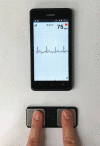Nurse Led Smartphone Electrographic Monitoring for Atrial Fibrillation after Ischemic Stroke: SPOT-AF
- PMID: 33053954
- PMCID: PMC7568969
- DOI: 10.5853/jos.2020.00689
Nurse Led Smartphone Electrographic Monitoring for Atrial Fibrillation after Ischemic Stroke: SPOT-AF
Abstract
Background and purpose: Paroxysmal atrial fibrillation (PAF) underlying acute stroke frequently evades detection by standard practice, considered to be a combination of routine electrocardiogram (ECG) monitoring, and 24-hour Holter recordings. We hypothesized that nurse-led in-hospital intermittent monitoring approach would increase PAF detection rate.
Methods: We recruited patients hospitalised for stroke/transient ischemic attack, without history of atrial fibrillation (AF), in a prospective multi-centre observational study. Patients were monitored using a smartphone-enabled handheld ECG (iECG) during routine nursing observations, and underwent 24-hour Holter monitoring according to local practice. The primary outcome was comparison of AF detection by nurse-led iECG versus Holter monitoring in patients who received both tests: secondary outcome was oral anticoagulant commencement at 3-month following PAF detection.
Results: One thousand and seventy-nine patients underwent iECG monitoring: 294 had iECG and Holter monitoring. AF was detected in 25/294 (8.5%) by iECG, and 8/294 (2.8%) by 24-hour Holter recordings (P<0.001). Median duration from stroke onset to AF detection for iECG was 3 days (interquartile range [IQR], 2 to 6) compared with 7 days (IQR, 6 to 10) for Holter recordings (P=0.02). Of 25 patients with AF detected by iECG, 11 were commenced on oral anticoagulant, compared to 5/8 for Holter. AF was detected in 8.8% (69/785 patients) who underwent iECG recordings only (P=0.8 vs. those who had both iECG and 24-hour Holter).
Conclusions: Nurse-led in-hospital iECG surveillance after stroke is feasible and effective and detects more PAF earlier and more frequently than routine 24-hour Holter recordings. Screening with iECG could be incorporated into routine post-stroke nursing observations to increase diagnosis of PAF, and facilitate institution of guideline-recommended anticoagulation.
Keywords: Atrial fibrillation; Electrocardiography; Smartphone; Stroke.
Figures



References
-
- Sposato LA, Cipriano LE, Saposnik G, Ruíz Vargas E, Riccio PM, Hachinski V. Diagnosis of atrial fibrillation after stroke and transient ischaemic attack: a systematic review and meta-analysis. Lancet Neurol. 2015;14:377–387. - PubMed
-
- Rizos T, Wagner A, Jenetzky E, Ringleb PA, Becker R, Hacke W, et al. Paroxysmal atrial fibrillation is more prevalent than persistent atrial fibrillation in acute stroke and transient ischemic attack patients. Cerebrovasc Dis. 2011;32:276–282. - PubMed
-
- Stahrenberg R, Weber-Krüger M, Seegers J, Edelmann F, Lahno R, Haase B, et al. Enhanced detection of paroxysmal atrial fibrillation by early and prolonged continuous holter monitoring in patients with cerebral ischemia presenting in sinus rhythm. Stroke. 2010;41:2884–2888. - PubMed
-
- Schnabel RB, Haeusler KG, Healey JS, Freedman B, Boriani G, Brachmann J, et al. Searching for atrial fibrillation poststroke: a white paper of the AF-SCREEN International Collaboration. Circulation. 2019;140:1834–1850. - PubMed
-
- Lazzaro MA, Krishnan K, Prabhakaran S. Detection of atrial fibrillation with concurrent Holter monitoring and continuous cardiac telemetry following ischemic stroke and transient ischemic attack. J Stroke Cerebrovasc Dis. 2012;21:89–93. - PubMed
Grants and funding
LinkOut - more resources
Full Text Sources

